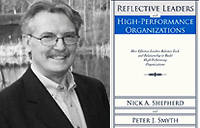How to lead effectively is a topic Peter Smyth, a long-term sessional faculty member in York’s School of Social Work, has spent years perfecting.
He’s now co-authored a book on the subject, Reflective Leaders and High-Performance Organizations: How Effective Leaders Balance Task and Relationship to Build High Performing Organizations, which reflects his extensive experience in group work, counselling and consultation in leadership development. Co-author Nick Shepherd has had wide-ranging experience in organizational management and  performance improvement. Together, they put their concepts into practice in public and private sector organizations for two decades.
performance improvement. Together, they put their concepts into practice in public and private sector organizations for two decades.
The book shows how an effective leader can create a culture that brings together the equally important aspects of organizational task (delivering on the vision and mission), and developing effective relationships, based on self-awareness, core values and intentional behaviour.
In many 21st century organizations the key competitive advantage comes from human capital, and it is the role of every leader to ensure effective engagement, collaboration, cooperation and communication, says Smyth. These aspects must not only be in place internally, but must extend to the key stakeholders who are often partners in design, development, delivery and support of an  organization’s business activity.
organization’s business activity.
Peter Smyth
Shepherd and Smyth show, through their RP5© Leadership and Management Model, why an organization’s culture must be founded on the joint pillars of “what we do, and how we behave when we do it”; the “R” standing for reflective leadership, while the five “P’s” reflect the core aspects of purpose, passion, process, partners and performance. The underlying values-based approach to organizational development provides the foundation for action. In addition, the authors present a circular team development model as a continuous process of six stages – rather than the traditional linear approach of “forming, storming, norming and performing”, that may be familiar to many.
Combining both the reasons why this style of leadership is becoming critical in today’s economy, with a framework of key steps to move forward by way of examples of how organizations have actually applied the concepts, Shepherd and Smyth provide a roadmap to building conscious and effective leadership.


